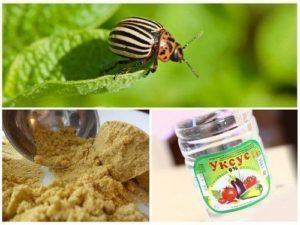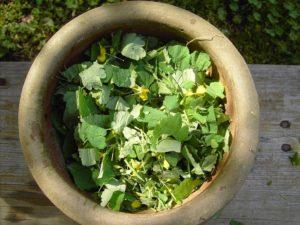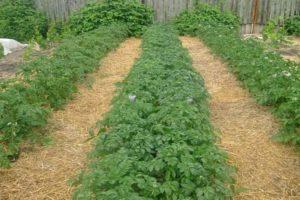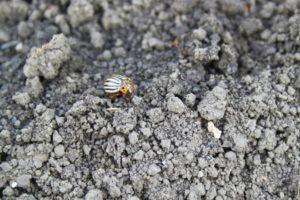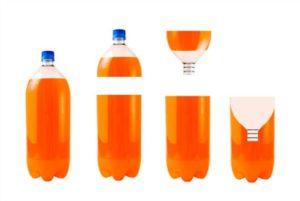16 proven folk remedies for the Colorado potato beetle - planting protection methods
Despite the high efficiency and ease of use of pesticides, most farmers are in no hurry to use them on their plots. Such preparations contain dangerous substances that can accumulate over time in the soil, tubers and fruits of the plant, and also harm beneficial insects. A safer and more environmentally friendly substitute for "chemistry" are folk methods and recipes.
Content
Infusions and decoctions against the Colorado potato beetle
Folk remedies to combat pests quite a lot and instead chemicals, you can use one of the effective folk recipes.
Mustard
An excellent result in the fight against the Colorado potato beetle gives a solution based on mustard powder. To prepare the liquid you will need:
- about 50 g of dry powder;
- 7-10 liters of water;
- 100-150 ml of vinegar.
With the resulting mixture, it is necessary to carefully treat the beds affected by the pest.
Celandine
This plant copes well with the striped pest, and both infusion and decoction of celandine can be used to process potatoes. For infusion, you need a bucket of water, 1,5 kg of fresh or dry celandine and 1 liter of potassium chloride. Having combined all the ingredients, you should infuse them for 3 hours.
To prepare a decoction, it is enough to fill a large pot or bucket with vegetable matter, pour water and boil for 15-20 minutes over low heat. Both fresh and dried plants can be used.
After cooling, it is necessary to strain the broth and dilute with water before spraying. For 10 liters of water you need 0,5 liters of decoction.
Sagebrush
Wormwood is also a proven remedy for various garden pests. An infusion prepared according to the following recipe will help get rid of the larvae of the Colorado potato beetle:
- 1 cup wormwood leaves;
- 1 glass of wood ash;
- 7-10 liters of hot water.
Dry ingredients must be thoroughly mixed and infused for 2-3 hours. Ready infusion should be filtered and add 1 tablespoon of laundry soap to it.
So that the infusion helps to get rid of not only larvae, but also from adult beetles, add to it:
- 400 g of wormwood;
- 100 g garlic leaves;
- 100 g of fresh celandine;
- 10 hot red peppercorns.
All herbal ingredients are poured with a bucket of hot water, and infused for 6-8 hours.
Walnut
To prepare a walnut-based product, you can use the shell, fresh and dried leaves or green fruits. When using fresh leaves and green fruits, you need 1 kg of raw materials per 10 liters of water. Walnut foliage is poured with boiling water and insisted for a week. After filter and use for spraying.
The other option walnut infusion is prepared from the following ingredients:
- 300 g of shell;
- 2 kg of dry leaves;
- 10 liters of boiling water.
All components are mixed and infused for 7-10 days. The finished infusion is filtered, a small amount of laundry soap is added and the affected plants are treated.
Simple infusions and decoctions
| Lukovaâ Husk | To prepare this remedy, you need about 300 g of onion peel. Prepared raw materials must be poured with a bucket of hot water and left to infuse. After 24 hours, the resulting infusion must be filtered and sprayed onto the infected beds. |
| Bitter pepper | A decoction of dry hot pepper copes very well with a potato pest. For cooking, dissolve 100 g of pepper in 10 liters of water, bring the resulting mixture to a boil and simmer for about 2 hours. In order for the resulting solution to keep well on potato bushes, 40 g of soap is added to it before processing. |
| Garlic | For the preparation of garlic infusion, the heads and arrows of the plant are used. 10 g of chopped garlic are added to 200 liters of water and left to infuse for 24 hours. A little soap is also added to the finished infusion before spraying. |
| Tobacco | Treatment with tobacco infusion is also excellent in the fight against the Colorado potato beetle. For the preparation of the product, both fresh plant stems and dry tobacco dust are suitable. 10 g of the plant component are added to 500 liters of water, mixed thoroughly and allowed to infuse for 48 hours. |
| Birch tar | To prepare the solution, you need 100 ml of birch tar. The substance is diluted with 10 liters of water and mixed thoroughly. The resulting liquid is sprayed 3 times a week on the beds affected by the pest. |
"Dry" methods against the Colorado potato beetle
Quite effective in the fight against the Colorado potato beetle is also dusting and mulching the affected beds.
Dusting
Dusting is the sprinkling of the green part of plants and row spacing by various means. The most effective is the use of the following substances:
Regular pollination of bushes with sifted wood ash helps to destroy both adult beetles and larvae. Ash dusting is best done early in the morning, before the dew dries on the leaves. The result of dusting is noticeable within a couple of days after the procedure. To process 1 acre of land, you need about 10 kg of ash.
Corn flour. The flour eaten by the Colorado potato beetle increases in size several times and leads to the death of the insect. The most effective will be dusting leaves that are wet from dew or rain.
Only dry leaves should be pollinated with these powders, otherwise the desired result will not be obtained. After dry gypsum or cement enters the stomach of an insect, it hardens and leads to the death of the pest.
Mulching
Most pests hate strong odors, and the Colorado potato beetle is no exception. The smell of fresh wood it helps to scare off the striped pest, so many experienced farmers generously mulch the aisles of potato beds with fresh sawdust.
Pine and birch sawdust are considered the most effective in this matter. Before the plants begin to bloom, sawdust should be renewed twice a month, and after that once a month is sufficient.
Traps and baits for the Colorado potato beetle
Another popular way of dealing with the Colorado potato beetle is the arrangement of traps and laying out baits.
Potato baits
As soon as the sun begins to warm the earth, the beetles wake up after their winter sleep and go in search of food. To significantly reduce the number of pests on the site, it is enough to decompose them in different places on the site a couple of weeks before planting. potato slices or even peeling.
Feeling the familiar smell, the beetles will surely crawl to the surface to refresh themselves. After that, it remains only to carefully collect cleanings from the ground along with pests and destroy them. If you repeat this procedure at least 2-3 times before landing, the Colorado population will become several times smaller.
trench trap
Such traps are also effective in early spring. Digging in the area deep trench with steep slopes and cover it with a dense black film. Along the perimeter of the film, small holes are made for drainage at a distance of about 3 m from each other.
At the bottom of the trench, baits are placed in the form of pieces of raw potatoes soaked in a strong solution of urea. Most pests that come to the smell of food die on the spot from poison or from heat, and beetles that were able to escape through drainage holes become victims of fungi that developed in a warm, humid environment under the film.
Traps from glass and tin cans
These traps will be effective both before planting potatoes and after. For their arrangement, glass jars with a volume of 1 or 0,5 liters, as well as deep tin cans from canned food, are suitable.
Put on the bottom of the container sliced potatoes, previously soaked in a strong solution of urea, and the edges of the jar are smeared with potato juice. The finished trap is buried in the ground in the evening, leaving the neck on the surface. On the morning of the next day, all that remains is to destroy the caught pests and renew the bait inside the trap.
Conclusion
Saving the crop from the Colorado potato beetle without the use of pesticides is a very real and feasible task. In order to cope with a dangerous pest, it is enough to lay out baits in a timely manner and regularly treat the beds with one of the above means.
